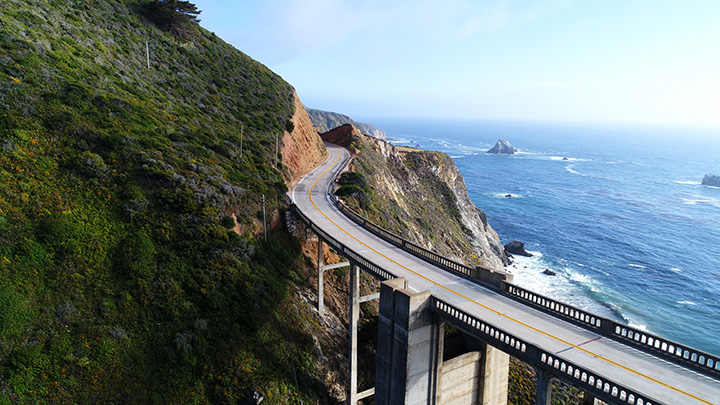SANTA BARBARA, Calif. — There’s been a large truck collision every week, and almost two fatalities per year, on average over the past five years along the California highways over which ExxonMobil wants to send as many as 70 oil tanker trucks a day, according to California Highway Patrol (CHP) data analyzed by the Center for Biological Diversity.
Santa Barbara County will soon vote on ExxonMobil’s proposal to restart its dormant offshore drilling platforms and truck that oil along coastal Highway 1, Highway 101 and the notoriously hazardous Route 166.
“This disturbing data shows that ExxonMobil will endanger California’s motorists and communities to get its offshore oil flowing again. Santa Barbara County officials can’t let that happen,” said Stephanie Prufer, an organizer with the Center for Biological Diversity. “Route 166 is just too treacherous for these tanker trucks. A crash along coastal Highway 1 could cause yet another oil spill in the Pacific Ocean.”

The data shows there were 216 large-truck collisions requiring a police response, 92 injuries and nine deaths between January 2015 and March 2020 along the proposed trucking route. The data includes tanker trucks, tractor-trailers and box trucks. A time-lapse data visualization video shows the locations of the collisions and deaths, which are concentrated along the narrow, winding Route 166 that ExxonMobil wants to use to truck its offshore oil to a refinery in Kern County.
On July 30, Santa Barbara County released the final environmental impact report (FEIR) on ExxonMobil’s proposal to transport oil by tanker trucks so it can restart three drilling platforms off California, setting up a vote on the project.
The plan calls for up to 70 oil-filled trucks per day on coastal Highway 101 and Route 166, 24 hours a day, seven days a week. The Santa Barbara County Planning Commission is scheduled to hold hearings on the project on Sept. 2 and Sept. 9 before voting on the matter.
“ExxonMobil would put California communities and motorists in harm’s way, just to restart its dirty and dangerous offshore platforms,” said Kristen Monsell, ocean legal director at the Center for Biological Diversity. “Sending oil tanker trucks along California’s coastal highway all day and night risks deadly accidents. Santa Barbara County should reject this reckless plan and urge ExxonMobil to decommission its platforms. We should end offshore drilling along this beautiful, bountiful coastline, not revive it.”
The FEIR concludes that there would be significant, unavoidable impacts from the project, including significant impacts on wildlife and cultural resources in the event of an oil spill from a tanker truck. The FEIR does not analyze the impacts of bringing Exxon’s offshore platforms back online.
“The county’s Final Environmental Impact Report fails to disclose the devastating impacts that will result if ExxonMobil is allowed to resume oil drilling in the Santa Barbara Channel and truck oil along our scenic highways,” said Linda Krop, chief counsel for the Environmental Defense Center, which represents Get Oil Out! and SBCAN. “ExxonMobil’s proposal will result in more oil spills, air pollution, and increased climate change at a time when we need to pursue clean energy alternatives.”
A majority of Santa Barbara County voters say they oppose proposals to restart ExxonMobil’s offshore drilling platforms in the Santa Barbara Channel, according to a recent poll. Nearly three out of every four respondents said they were concerned “about the safety of our local highways if up to 70 oil tanker trucks are allowed on our roads each day.”
ExxonMobil’s three offshore platforms near Santa Barbara were shut down in 2015 after the Plains All American Pipeline ruptured, spilling thousands of gallons of oil along the California coast. The company proposes to restart the platforms and load offshore oil onto tanker trucks at its Las Flores Canyon processing facility. The trucks would transport as much as 470,400 gallons of oil per day up to 140 miles to refineries in Kern County and Santa Maria.
California experiences hundreds of oil-truck incidents a year, and many of those incidents result in oil spills. There were 216 trucking accidents along the route between 2015 and 2020, resulting in nine deaths and 92 injuries, according to data from CHP.
The coalition opposing ExxonMobil’s trucking plan includes Wishtoyo Chumash Foundation, 350 Santa Barbara, Center for Biological Diversity, Environmental Defense Center, Food and Water Action, GOO!, SBCAN, Sierra Club’s Los Padres Chapter, UCSB Academic Senator Esmeralda Quintero-Cubillan and Surfrider Foundation Santa Barbara County Chapter.
The Trucker News Staff produces engaging content for not only TheTrucker.com, but also The Trucker Newspaper, which has been serving the trucking industry for more than 30 years. With a focus on drivers, the Trucker News Staff aims to provide relevant, objective content pertaining to the trucking segment of the transportation industry. The Trucker News Staff is based in Little Rock, Arkansas.









Interesting that you would choose a picture of the Bixby Creek Bridge for this article, being that the bridge is 211 miles from Santa Barbara. And the statistics chosen by the groups discussed in this article are completely flawed. Playing politics are we? How stunning. Guess this is actually the “New Normal”…